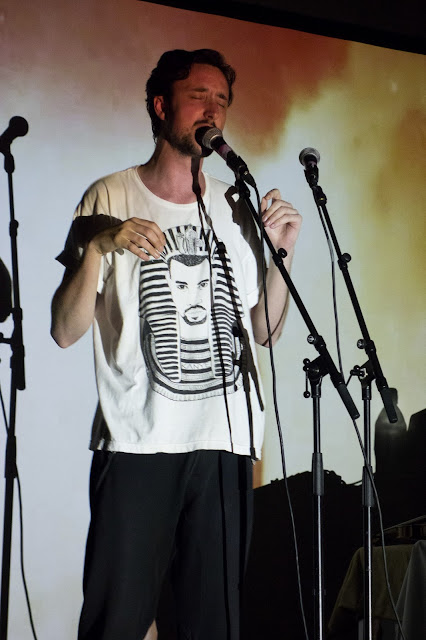Concert reviews and reactions to recent Indie releases from a music lover with a background in classical music. You can follow me as jeremyindie on Twitter.
Thursday, May 16, 2013
How To Dress Well, Whitworth Gallery Manchester, 16th May 2013 7.5/10
There have attempts to make classical music more relevant to a younger audience by borrowing presentational techniques from the popular world. Last night, though it felt as if the reverse was happening: the atmosphere was formal and the audience sat in hushed, reverential silence. This can be attributed to the art gallery venue, which seemed appropriate for the minimalist, intellectual nature of the music. Links to the classical tradition were reinforced by the playing of Philip Glass over the PA before the start of the gig, along with Brian Eno. The devastating energy of the talented support band GREaTWAVES surpassed any acoustic music I've seen, all the more effective for its contrast with the serenity around.
In certain respects, How To Dress Well suffered by comparison with this stellar support act: specifically the absence of guitars and a heavy reliance on a pre-recorded backing track reduced the spontaneity. Tom Krell was accompanied by a violinist, who also operated the electronics, but it didn't really feel as if the studio sound was being fully recreated live: instead it was being replayed. Visually the use of the projection screen as the sole lighting source was highly effective, and the screening of conceptual films and abstract patterns gave the impression of an art installation. The overall mood was intentionally sombre: one of the most effective songs had the title Suicide Dream 2.
Tom has a PHD in philosophy, and whilst his Chicago origin gives him an American accent, his adopted home of Cologne he evident in the serious nature of the material: it has gravitas, and the lyrics are as heavy as a tragic opera's. However, this weight is unexpectedly carried by a pop music genre, as if he is trying to break free of convention, setting up a dichotomy to surprise the audience. This does seem to be his intention: he stated in an interview 'pop musical forms seem to have been set free from their populist structures'. He moves his body to the music, but vigorous dancing was absent: the emotions conveyed here are largely introverted. It was quite a draining experience, and the tension in the music felt harrowing and draining.
If I admired this performance more than got lost in it, it's impossible to ignore the most remarkable element: almost perfect falsetto vocals, with a technique borrowed from R&B. Tom alternated between reverb and dry mics, and neither in the remarkable a capella encore, which showed that the power of this voice is not reliant on electronic trickery. It seems initially surprising that he has a voice which has been compared to Prince's and Frank Ocean's; others have cited the Cocteau Twins as an influence. It's an ethereal sound, which sounds other worldly, expressing hidden passions. Some have found the atmosphere he creates almost religious: for me it was certainly cathartic. Critical opinion is almost universally favourable, not surprising since the act is a clever post-modern construct: Pitchfork awarded his first album Love Remains its Best New Music accolade.
In a final twist, Tom's spoken interjections between songs were warm, friendly and at odds with the gravitas elsewhere. This reinforces the feeling that this he is adopting a stage persona: the songs may be about his family, and personal pain, but I came out pondering the boundaries between art and reality, and wondering if we'd been manipulated psychologically. Tom contradicted this thought when he said: 'I think that art is a magnified, intensified form of general human life', and that his acclaimed 2012 second album Total Loss concerns 'learning how to overcome melancholy in the direction of spiritual regeneration'. Yet, despite the vocal display, arresting visuals and a beautifully apt venue, I left the gig feeling a slightly cold: a spectator to art instead of personally transformed by the experience.
Subscribe to:
Post Comments (Atom)






No comments:
Post a Comment